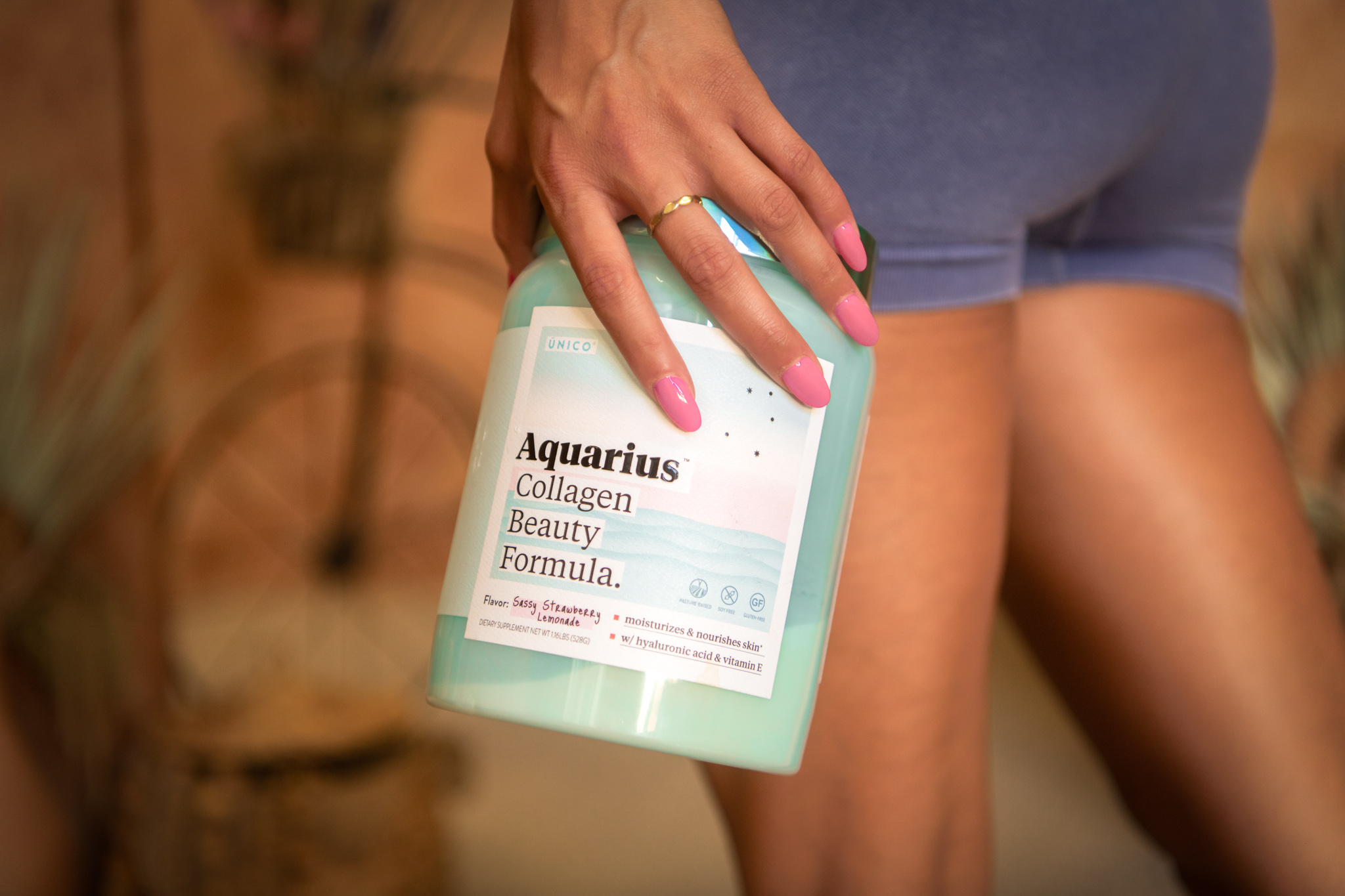Social media and magazines may have falsely led you to believe that the backs of your legs, buttocks, and abdomen should be smooth and free of unsightly cellulite.
For most women (and even some men), this is not reality.
Many spend large amounts of time and effort trying to get rid of these normal dimples that appear on the skin, called cellulite.
While cellulite is completely normal, even for women of a normal weight, you still may be wondering if you can reduce its lumpy appearance.
So, is there anything you can do to improve the appearance of your skin?
Let’s find out.

What is Cellulite?
Cellulite is a globule of fat under the skin that pushes through the connective tissues, leading to a “cottage cheese” look that some look to avoid.
Connective tissues are skin and muscle that help keep the body intact.
This lumpy or dimpled appearance commonly occurs in the buttocks, thighs, and abdominal area, where there is the most body fat.
Cellulite is most common in women.
In fact, over 85% of women have cellulite, to some extent.1
This is due to the physical structure of women’s connective and muscle tissue in those areas of the body and greater percentage of body fat compared to men.
It can also get worse with age as skin elasticity and the connective tissue strength starts to break down.
Women with more body fat may have more cellulite, but it can be present even in women with a normal body weight.
It is not an indication of poor health or other concerns, it is simply part of being a woman.
While you can’t get rid of cellulite completely, helping maintain healthy connective tissue can help reduce its appearance as you age.
This is where collagen comes in.
What is Collagen?
Collagen is the structural protein of the body.
It is found in the skin, joints, ligaments, and tendons.
As we age, we begin to lose collagen at the rate of about 1% per year,2 and our bodies become less effective at replacing what has been lost.
The loss of collagen over time is what leads to wrinkles, age-related dryness, and even the worsening appearance of cellulite.
There are many ways to slow down age-related collagen loss, but you can’t stop it completely.
A healthy diet with adequate protein, antioxidants, and vitamin C can all help protect existing collagen.
Protecting the skin from sun damage can help as well, as UV rays speed up the breakdown of collagen.
Taking collagen peptide supplements can also help the body protect the collagen it has, which over time may improve the appearance of cellulite or prevent it from getting worse.
Collagen and Cellulite: What the Research Says
While there is a significant amount of research on the effects of collagen on wrinkles, there is only one study on how collagen supplements impact the appearance of cellulite.
In this 2015 randomized clinical trial, researchers evaluated the effect of collagen peptides on cellulite of both normal and overweight women.
The 105 subjects were all between the ages of 24-50. They received 2.5 grams of collagen peptides or a placebo for 6 months.3
Researchers evaluated the degree of cellulite, skin waviness, and dermal density at 3 and 6 months.
In normal weight women, collagen significantly reduced cellulite and skin waviness on the thighs. It also increased skin density.
The impact of the collagen was seen in the overweight women as well, but the results were not as pronounced.
While this is only one small study, it has promising results.
With the other benefits of collagen for wrinkles and dryness, collagen peptides are a great addition to your beauty routine.4
How to Take Collagen for Cellulite
If you want to harness the power of collagen, the best collagen powder for cellulite (and skin) is a product that contains types 1 and 3.
These types of collagen are found primarily in the skin, whereas type 2 is mostly found in the joints.5
Since collagen is a connective protein, it is made from the skin, bones, and hides of animals.
Types 1 and 3 collagen are usually in bovine (cow) or chicken sources.
At this time, there is no plant-based collagen available on the market (although they are working on it!)
Most collagen products on the market do not contain intact collagen protein, as it is very difficult to digest.
Instead they contain collagen peptides, which are broken down protein pieces that the body can digest and absorb.
There has not been an optimal dose established for collagen, although there are some general guidelines around how much collagen to take per day.
The study discussed above found beneficial effects for cellulite with just 2.5 grams of collagen peptides per day.
Many products on the market contain 15-20 grams.
At this time, it is unclear what is optimal for cellulite.
That being said, there are no significant side effects to taking collagen peptides.
Some people do report some stomach distress, but this is uncommon.
Always speak to your doctor about what is best for you.
The great news is that collagen peptides are super easy to add to your routine.
Most are flavorless powders that dissolve completely in your beverage of choice.
Adding it to your morning coffee, tea, or smoothie is a great way to support the health of your skin and help decrease the appearance of cellulite.
Other Tips to Reduce Cellulite Naturally
While you can’t completely get rid of cellulite, some of it is just genetic, there is a lot you can do to improve the appearance of your skin.
Here are a few additional things that that can help beyond collagen supplements:
- Weight training. Exercises that tone up the hips, thighs, and buttocks like lunges and squats can help reduce the appearance of cellulite.
- Plastic surgery. While plastic surgery with lasers or liposuction can be effective for reducing the appearance of cellulite, it can also be painful and expensive.
- Massage. Certain massage techniques, like lymphatic drainage, can improve the appearance of cellulite.6
- Maintain a healthy weight. The more body fat you have, the more cellulite will appear. While normal weight women have cellulite too, maintaining a healthy body fat can help decrease its appearance. A natural weight-loss supplement can help accelerate weight-loss.
- Topical creams. There are several creams that will temporarily plump the skin to reduce the appearance of cellulite, but this is not a permanent solution.
- Hydration. When skin cells get dehydrated, cellulite can look worse. Aim to drink at least 8-11 cups of water daily to maintain hydration.
- Eat less salt and refined carbohydrates. Eating less processed foods can help decrease water retention and inflammation, which may improve the appearance of the skin.
- Radical self-acceptance. Cellulite is part of life. A healthy lifestyle can help, but radically accepting your body for its lumps and bumps can also help you feel better about it.
The bottom line about cellulite is that most women struggle with it. It is not an indication of poor health or that you need to lose weight. Exercise, hydration, a healthy diet, antioxidants, and a daily dose of your favorite collagen peptides can help reduce its appearance, but may not give you the perfectly smooth skin you dream of. Focus instead on creating healthy habits and loving yourself, cellulite at all.
References:
1https://www.asds.net/skin-experts/skin-conditions/cellulite
2https://www.ncbi.nlm.nih.gov/pmc/articles/PMC1606623/
3https://www.ncbi.nlm.nih.gov/pmc/articles/PMC4685482/
4https://www.karger.com/Article/Abstract/355523
5https://www.ncbi.nlm.nih.gov/books/NBK21582/
6https://www.ncbi.nlm.nih.gov/pmc/articles/PMC3359771/
- The Pros and Cons of a Vegan Diet, According to a Dietician - March 29, 2022
- Does Collagen Reduce Cellulite? - January 11, 2022
- 6 Different Types of Protein Powder – Which is Best? - December 21, 2021
